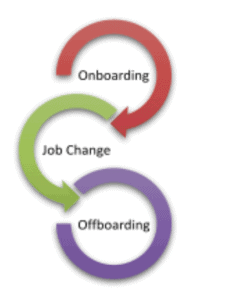Between increased security breaches and the speed needed to staff up after COVID, the face of onboarding has been changing over the last couple of years. For many years, IT and HR ran their separate processes. HR covered all compliance-related work and provided employees with everything they needed to start work. IT, Facilities, and Security worked together or separately to ensure access (building and systems), equipment, and workspace. It’s not just onboarding, either. Job changes are more of a challenge in many organizations because no one remembers to tell IT about the change. Offboarding is a similar challenge, with providers often finding out long after an employee is gone. Now technology enables these services to come together if the providers are ready and have a unified process.
Table of Contents
ToggleUnderstanding a Unified Employee Lifecycle Process
There are three employee journeys to be defined for a unified process: onboarding, job change, and offboarding (or termination). They all begin in HR, putting HR at the center of the processes.
Consider the employee lifecycle and the processes that go along with them if technology is leveraged to the fullest:

Onboarding: The HR system kicks off the process when an offer is accepted. The Identity Access Management (IAM) solution creates an appropriate account through integration, with role-based access to all required systems. The service management system has an automated ticket opened for all the provisioning required across all providers: facilities for workspace, corporate security for badge access, and IT for all equipment and software. The new hire submits a photo for their badge and completes all required documents electronically via an onboarding application on their phone.
Job change: The HR system kicks off all required changes through the Identity Access Management solution and the service management ticketing system. Access is automatically adjusted on the first day in the new role, software/desktop reimaging occurs, and badge access is adjusted. Facilities is aware of a desk or location change and managed appropriately. In-country changes where equipment needs to be collected and reissued, tickets to do so are automatically created. All providers are in the loop.
Offboarding: When an employee leaves, the HR system triggers automated termination of all access, physically and system, IT and facilities are made aware of the need to recover assets and desk space.
There are three systems of work in this example, all connected via integration:
- HR or Human Capital Management system is the gold source for employee information. It provides information about the employee’s department and title or role. It retains current information as the employee moves from job to job within the organization until they leave the organization.
- Identity Access Management solutions are becoming more common in organizations as they struggle to keep up with security and compliance requirements. IAM is the only effective way to ensure the right people have the right access to the right systems at the right time. While this has been done manually by organizations for many years, it’s not scalable and not as effective.
- Service Management systems or ticketing systems are fairly common to this audience, but they can be extended beyond IT to bring an integrated process together and form the employee-facing solution for phone-based onboarding and for portal-based support once on board.
The key to building the solution designed here is to expect it to be a journey and to expect to bring multiple stakeholders together to align on what the final solution looks like and to expect several initiatives that can be built in an agile manner then brought together over time. Consider the following areas:
- Role-based provisioning is a journey of its own as titles or roles need to be aligned with access, software, equipment, and accessories. Managers need to be involved, as they will need to be ready to accept standardization or an opportunity to request exceptions is needed as part of the process.
- Automating the automated HR onboarding process, ensuring automated background checks, right to work (I-9 or visa validation), photo uploads and required forms, policies and agreements are ready.
- Ability to manage remote, hybrid and on-site work arrangements in an automated fashion, with providers aware of the needs for each employee. The ability to auto-assign space or allow floor plan integration with the process is key for on-site workers, which an appropriate level of open cube space needs to be available for hybrid workers when they come into the office. This changes how facilities operates but is needed in our post-pandemic way of working.
Each initiative needed to bring the whole together can be built in phases using a minimum viable product approach, adjusting and refining as the entire program is developed. The final result of this is two-fold: automated Identity Access Management makes it harder for unauthorized individuals to gain access to the computing environment as access is tightly controlled throughout the entire employee life cycle and onboarding and other changes become automated and scalable, a significant achievement in a world where employee change has become as rapid as it is today. Finally, the employee experience is improved, from the cradle to the grave. They no longer need to be concerned about having what they need as they go through the process. The HR system and automation make sure they do.





